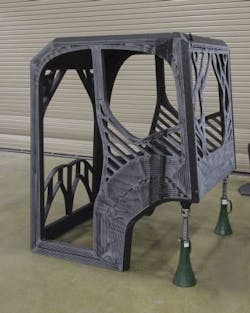3D-printed excavator project advances large-scale additive manufacturing R&D
Heavy construction machinery is the focus of Oak Ridge National Laboratory (ORNL; Oak Ridge, TN)'s latest advance in additive manufacturing research. With industry partners and university students, ORNL researchers are designing and producing a 3D-printed excavator, a prototype that will leverage large-scale additive manufacturing technologies and explore the feasibility of printing with metal alloys.
Increasing the size and speed of metal-based 3D printing techniques, using low-cost alloys like steel and aluminum, could create new industrial applications for additive manufacturing.
The excavator will be 3D-printed using machines at the Department of Energy's Manufacturing Demonstration Facility at ORNL to create and assemble three components: the cab where the operator sits, the stick (a large hydraulically articulated arm), and a heat exchanger. The excavator's stick will be fabricated using the newly installed Wolf System, a machine that uses a freeform technique in printing large-scale metal components. The heat exchanger will be printed on a Concept Laser machine that produces metal parts through a powder-bed-based laser melting process.
When 3D printing the excavator's stick and heat exchanger, the team will further develop processes to improve material performance and printability and also validate models that will show how they can adapt to reduce residual stress and distortion. Lonnie Love, who is leading the 3D-printed excavator project with ORNL's Manufacturing Systems Research group, expects the excavator to be printed, assembled, and ready to be unveiled in nine months.
The completed excavator project, known as Project AME (Additive Manufactured Excavator), will be on display at IFPE and CONEXPO-CON/AGG in Las Vegas, NV, in March 2017. Plans are in the works to 3D-print another excavator cab during a live demonstration at the event.
While 3D printing excavators, or any other construction vehicles, may not become common practice among manufacturers, Love says that using additive manufacturing to print low-volume, high-complexity components could benefit the construction industry by reducing production time and overall cost.
For more information, please visit www.ornl.gov.
